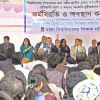Creative method still ineffective

Teachers of more than 40 percent secondary schools still cannot set question papers in creative method though seven years have gone since its introduction, according to a latest government report.
They either depend on question papers from outside or take help of fellow teachers from other institutions to compose questions to conduct internal exams.
Released on Sunday, the report was based on a survey of 6,594 out of countrywide 18,598 schools, conducted in Dhaka, Mymensingh, Sylhet, Chittagong, Rangpur, Rajshahi, Khulna, Barisal and Comilla regions by the planning and development unit of the Directorate of Secondary and Higher Education (DSHE).
The survey found that over 16 percent schools bought question papers from teachers' associations for internal exams last year while teachers of over 23 percent schools took help of their colleagues from other schools to compose questions as they could set those partially, as per the Academic Supervision Report, November-2015.
The education ministry claimed to have trained some 5 lakh teachers of different subjects in phases in this method since its introduction at the secondary level in 2008.
The new textbooks brought out in the light of the method do not have any sample question. Students first answered to creative questions in 2010 Secondary School Certificate exams.
The officials and even the education minister on many occasions attributed the overall improvement of education, especially the gradual increase in the pass rates in SSC exams, to the creative method of teaching.
However, the report reveals that teachers of 1,105 out of the institutions surveyed bought question papers from teachers' associations, defying the government order not to purchase question papers.
The government introduced the much-talked-about “creative question method” to discourage the age-old tradition of learning by heart.
At present, the modern method is being followed to teach all subjects except Bangla 2nd, English 1st and 2nd and mathematics.
"In order to make creative question method successful, collecting question papers from outside should be prohibited completely," DSHE said in the report.
Apart from the fact that many teachers are yet to adapt to the method, some teachers tend to be restricted to the orthodox method of teaching and learning process, an official of DSHE said.
"They seek help from guidebooks and notes to prepare questions, which is also a barrier [to the implementation of the method]," added the official who wished not to be named.
Teachers need vast knowledge about the subjects to go well with the modern teaching method but they are reluctant to work hard, he said.
"To prepare questions in creative method, teachers need to be creative first and give classroom lessons creatively and interactively so that students can use their cognitive thinking," noted educationist Prof Siddiqur Rahman told The Daily Star.
The number of such creative teachers in Bangladesh is limited, he added.
Prof Siddiqur, a former teacher of the Institute of Education and Research of Dhaka University, found some weaknesses of the training in the method.
The duration of training sessions arranged so far is insignificant and the way teachers have been trained does not help them much in acquiring efficiency, he said.
"Creativity does not have any limit, but in Bangladesh we have given a structure to it. What we are following is partial creative."
To have the system fully implemented, Siddiqur suggested recruiting efficient people in teaching profession and providing them with adequate training and proper facilities.
Education Minister Nurul Islam Nahid acknowledged the practice of schools' buying question papers.
The practice existed even before the creative method was introduced, he said by phone, adding that the ministry was taking steps to stop it.
More training sessions will be organised to help teachers, Nahid said.
Many teachers said they found it difficult to prepare questions for lack of reference books and relevant literature.
"The schools do not provide us with any reference book. It is not possible to set questions efficiently after only one training session," said a teacher of Khulna Zila School, seeking anonymity.
He added that the district and upazila education officers did not have any mechanism in place to monitor whether teachers were applying the method.
A teacher from Mymensingh said schools bought questions to cut cost.
The cost of composing questions on computers and printing them is higher than buying question papers. Therefore, many schools in rural areas buy them, he said.
The objective of introducing the method will be achieved only if teachers prepare question papers on their own, according to the report.
"Necessary steps should be taken so that teachers of every school set questions in creative method," DSHE said suggesting more training of teachers.

 For all latest news, follow The Daily Star's Google News channel.
For all latest news, follow The Daily Star's Google News channel. 








Comments